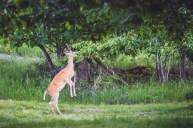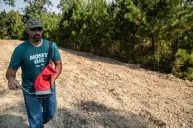Discouraged about your food plots this season? There's still hope.
Right now, there are things you can do that can still have an effect on the deer herd you're hunting this fall.
If you focus on a few late-in-the-game factors, follow a little advice, and accumulate a bit luck before Opening Day, you can count food plots as a winning piece of your hunting puzzle.
But here's the thing: You're sort of wasting time even reading this post. You need to be out there and you need to take action. Get through this list quickly, because every moment you have available to get your food plots in order, or at least set some things to memory, should be used wisely if you want to improve your chances.
These are just a few pointers that can apply to the late off-season food plot strategy, and hopefully line you up for a shot at the buck you've been watching since April.
1. Plant both hunting plots and nutrition plots.
Limit the hunting plots to good bedding cover, and make the nutrition ones larger and never hunt over them. That way, you're giving a reliable source of food to bring in plenty of deer, but keeping in mind the idea of cover and security, with the hopes that a buck would check out the smaller plots during the day. The larger plots are great locations for trail cameras.
2. Don't skimp
It's never worth it to buy cheap seeds. Go with a high-quality seed, and you'll get the best results in the limited time you still have available. Seriously, as of this date, you're not missing out on planting opportunities. Find out what would work best in your area, with your type of soil, planted this time of year. A quick online search can provide a lot of help, as can Sportsman's Guide's Whitetail Universe, a huge resource for all things leading up to (and during) deer season.
3. But do it stealthily
If you're busting around your prime treestand spots in an ATV this late in the season, you're pushing it. Try to do any late season planting or maintenance strategically, so as not to interfere with the normal deer movement around your area. Try to study trail cams placed around your plots to find out when they're not there, and use that time efficiently and wisely.
4. Good rotation
Always rotate crops, especially brassicas. If they're grown on the same site for more than two years in a row, things like disease and pest problems become a factor.
5. About face

If you lay plots facing south and west in late summer and fall, you'll be maximizing the amount of afternoon sunlight they receive.
6. Take notes
Keep a log of what you plant and where. It can be as simple as a handwritten notebook, or as sophisticated as a free (or inexpensive) computer data entry program. There are even garden-specific apps that can serve many of the basic purposes you'd want them for. Jot down the success of the planting sites and as much about how deer utilize them as you can, and apply it to future seasons of your property management.
It might seem like there's too little time and not enough that can be done to make a difference in the food plots used on your land, but that's actually not the case. Cash in now on the fact that you're not entirely at a loss, and you can still help bring big bucks to the spots you want them.
NEXT: SPORTSMAN'S GUIDE'S WHITETAIL UNIVERSE GIVES YOU A GAME PLAN FOR THE SEASON




